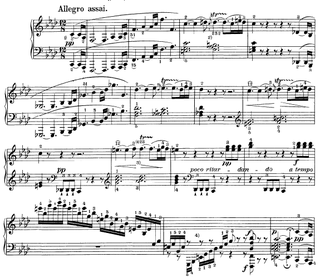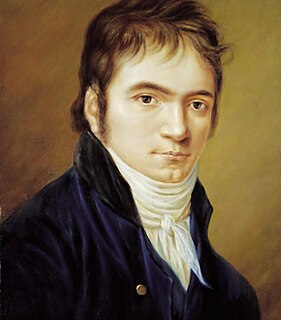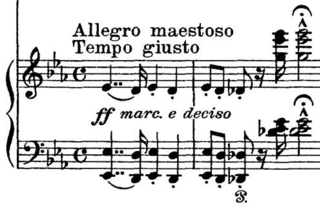Related Research Articles
In music, a glissando is a glide from one pitch to another. It is an Italianized musical term derived from the French glisser, "to glide". In some contexts, it is distinguished from the continuous portamento. Some colloquial equivalents are slide, sweep, bend, smear, rip, lip, plop, or falling hail.

Anton Grigoryevich Rubinstein was a Russian pianist, composer and conductor who became a pivotal figure in Russian culture when he founded the Saint Petersburg Conservatory. He was the elder brother of Nikolai Rubinstein, who founded the Moscow Conservatory.

Carl Czerny was an Austrian composer, teacher, and pianist of Czech origin whose music spanned the late Classical and early Romantic eras. His vast musical production amounted to over a thousand works and his books of studies for the piano are still widely used in piano teaching. He was one of Ludwig van Beethoven's best-known pupils.
Simon Barere was a Russian pianist. His surname Барер is transliterated Barer, but as an adult he adopted the spelling Barere in order to reduce the frequency of mispronunciation.

Ludwig van Beethoven's Piano Sonata No. 23 in F minor, Op. 57 is among the three famous piano sonatas of his middle period ; it was composed during 1804 and 1805, and perhaps 1806, and was dedicated to Count Franz von Brunswick. The first edition was published in February 1807 in Vienna.
Stephanie McCallum is a classical pianist. She has recorded works of Erik Satie, Ludwig van Beethoven, Charles-Valentin Alkan, Franz Liszt, Robert Schumann, Carl Maria von Weber, Albéric Magnard, Pierre Boulez, and Iannis Xenakis among others.

C minor is a minor scale based on C, consisting of the pitches C, D, E♭, F, G, A♭, and B♭. Its key signature consists of three flats. Its relative major is E♭ major and its parallel major is C major.

A major is a major scale based on A, with the pitches A, B, C♯, D, E, F♯, and G♯. Its key signature has three sharps. Its relative minor is F-sharp minor and its parallel minor is A minor. The key of A major is the only key where a Neapolitan sixth chord on requires both a flat and a natural accidental.

F major is a major scale based on F, with the pitches F, G, A, B♭, C, D, and E. Its key signature has one flat. Its relative minor is D minor and its parallel minor is F minor.

A-flat major is a major scale based on A♭, with the pitches A♭, B♭, C, D♭, E♭, F, and G. Its key signature has four flats.

D minor is a minor scale based on D, consisting of the pitches D, E, F, G, A, B♭, and C. Its key signature has one flat. Its relative major is F major and its parallel major is D major.

A minor is a minor scale based on A, with the pitches A, B, C, D, E, F, and G. Its key signature has no flats and no sharps. Its relative major is C major and its parallel major is A major.

Ludwig van Beethoven's Piano Concerto No. 1 in C major, Op. 15, was written in 1795, then revised in 1800. It was possibly first performed by Beethoven at his first public concert in Vienna on 29 March 1795. It was first published in 1801 in Vienna with dedication to his pupil Princess Anna Louise Barbara Odescalchi, known to her friends as "Babette".

Franz Liszt composed his Piano Concerto No. 1 in E♭ major, S.124 over a 26-year period; the main themes date from 1830, while the final version is dated 1849. The concerto consists of four movements and lasts approximately 20 minutes. It premiered in Weimar on February 17, 1855, with Liszt at the piano and Hector Berlioz conducting.

Dino Ciani was an Italian pianist.

Transcendental Étude No. 10 in F minor, "Appassionata", is the tenth Transcendental Étude of a set of twelve by Franz Liszt. It is possibly the most played of the études and has a prominent melody.
Lilya Efimovna Zilberstein is a Russian-born German pianist.
The Konzertstück in F minor for Piano and Orchestra, Op. 79, J. 282, was written by Carl Maria von Weber. He started work on it in 1815, and completed it on the morning of the premiere of his opera Der Freischütz, 18 June 1821. He premiered it a week later, on 25 June, at his farewell Berlin concert.
Tzvi Erez is an Israeli–Canadian pianist. He was born in Israel and began his piano studies at the age of six. He moved to Canada and graduated from The Royal Conservatory of Music, where he trained with Mildred Kenton, Andrew Burashko, and Antonin Kubalek. Erez has released over 33 albums worldwide, including Bach’s Well-Tempered Clavier, Partita 2, Goldberg Variations, Two-Part Inventions; Beethoven’s Piano Works, Sonatas, Piano Concerto No. 3; Chopin’s Complete Ballades, Etudes, Preludes, Piano Concertos No. 1 & 2; Debussy’s Suite Bergamasque; Liszt Piano Recital; Erik Satie’s Gymnopedies, Gnossiennes, and Cold Pieces; Mussorgsky’s Pictures at an Exhibition; Essential Classics, Masterpieces, Sentimental, Mozart’s Piano Sonatas, Rachmaninoff's Concerto No. 2 & 3, the Grieg Piano Concerto, the Robert Schumann Piano Concerto, the Tchaikovsky Piano Concerto, and others. Erez is active in new classical recordings, teaching piano performance and classical music research. He also assists artists in production and produced several film scores and music for television shows.

Detlev Eisinger is a German pianist.